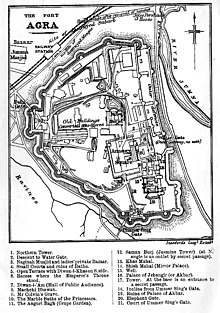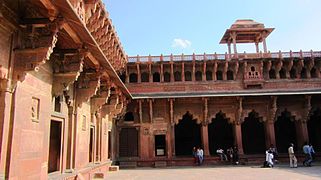Agra Fort
Agra Fort (Hindi: आगरा का किला, Urdu: آگرہ قلعہ) is a UNESCO World Heritage site located in Agra, Uttar Pradesh, India. It is about 2.5 km northwest of its more famous sister monument, the Taj Mahal. The fort can be more accurately described as a walled city.
| Agra Fort | |
|---|---|
| Name as inscribed on the World Heritage List | |

Entry gates of the Agra Fort
| |
| Type | Cultural |
| Criteria | iii |
| Reference | 251 |
| UNESCO region | South Asia |
| Inscription history | |
| Inscription | 1983 (7th Session) |
The present-day structure was built by the Mughals, though a fort had stood there since at least the 11th century. Agra Fort was originally a brick fort known as Badalgarh, held by Raja Badal Singh Hindu Sikarwar Rajputking (c. 1475). It was mentioned for the first time in 1080 AD when a Ghaznavide force captured it. Sikandar Lodi (1488–1517) was the first Sultan of Delhi who shifted to Agra and lived in the fort. He governed the country from here and Agra assumed the importance of the second capital. He died in the fort at 1517 and his son, Ibrahim Lodi, held it for nine years until he was defeated and killed at Panipat in 1526. Several palaces, wells and a mosque were built by him in the fort during his period.
After the First Battle of Panipat in 1526, Mughals captured the fort and seized a vast treasure, including the diamond later known as the Koh-i-Noor. The victorious Babur stayed in the fort in the palace of Ibrahim and built a baoli (step well) in it. The emperor Humayun was crowned here in 1530. Humayun was defeated at Bilgram in 1540 by Sher Shah. The fort remained with Suris till 1555, when Humanyun recaptured it. The Hindu kingHem Chandra Vikramaditya, also called 'Hemu', defeated Humanyun's army, led by Iskandar Khan Uzbek, and won Agra. Hemu got a huge booty from this fort and went on to capture Delhi from the Mughals. The Mughals under Akbar defeated King Hemu finally at the Second Battle of Panipat in 1556.
Realizing the importance of its central situation, Akbar made it his capital and arrived in Agra in 1558. His historian, Abdul Fazal, recorded that this was a brick fort known as 'Badalgarh' . It was in a ruined condition and Akbar had it rebuilt with red sandstone from Barauli area in Rajasthan. Architects laid the foundation and it was built with bricks in the inner core with sandstone on external surfaces. Some 4,000 builders worked on it daily for eight years, completing it in 1573.[1]
It was only during the reign of Akbar's grandson, Shah Jahan, that the site took on its current state. Legend has it that Shah Jahan built the beautiful Taj Mahal for his wife, Mumtaz Mahal. Unlike his grandfather, Shah Jahan tended to have buildings made from white marble, often inlaid with gold or semi-precious gems. He destroyed some of the earlier buildings inside the fort to make his own.
At the end of his life, Shah Jahan was deposed and restrained by his son, Aurangzeb, in the fort. It is rumoured that Shah Jahan died in Muasamman Burj, a tower with a marble balcony with a view of the Taj Mahal.
The fort was invaded by the Maratha Empire during the mid 18th century. Thereafter, it changed hands between the Marathas and their foes many times. After their catastrophic defeat at Third Battle of Panipat by Ahmad Shah Abdali in 1761, Marathas remained out of the region for the next decade. Finally Mahadji Shinde took the fort in 1785. It was lost by the Marathas to the British during the Second Anglo-Maratha War, in 1803.
The fort was the site of a battle during the Indian rebellion of 1857, which caused the end of the British East India Company's rule in India, and led to a century of direct rule of India by Britain.
The 94-acre (380,000 m2) fort has a semicircular plan, its chord lies parallel to the river and its walls are seventy feet high. Double ramparts have massive circular bastions at intervals, with battlements, embrasures,machicolations and string courses. Four gates were provided on its four sides, one Khizri gate opening on to the river.
Two of the fort's gates are notable: the "Delhi Gate" and the "Lahore Gate." The Lahore Gate is also popularly also known as the "Amar Singh Gate," for Amar Singh Rathore.
The monumental Delhi Gate, which faces the city on the western side of the fort, is considered the grandest of the four gates and a masterpiece of Akbar's time. It was built circa 1568 both to enhance security and as the king's formal gate, and includes features related to both. It is embellished with inlay work in white marble. A wooden drawbridge was used to cross the moat and reach the gate from the mainland; inside, an inner gateway called Hathi Pol ("Elephant Gate") – guarded by two life-sized stone elephants with their riders – added another layer of security. The drawbridge, slight ascent, and 90-degree turn between the outer and inner gates make the entrance impregnable. During a siege, attackers would employ elephants to crush a fort's gates. Without a level, straight run-up to gather speed, however, something prevented by this layout, elephants are ineffective.
Because the Indian military (the Parachute Brigade in particular) is still using the northern portion of the Agra Fort, the Delhi Gate cannot be used by the public. Tourists enter via the Amar Singh Gate.
The site is very important in terms of architectural history. Abul Fazal recorded that five hundred buildings in the beautiful designs of Bengal and Gujarat were built in the fort. Some of them were demolished by Shahjahan to make way for his white marble palaces. Most of the others were destroyed by the British between 1803 and 1862 for raising barracks. Hardly thirty Mughal buildings have survived on the south-eastern side, facing the river. Of these, the Delhi Gate and Akbar Gate and one palace – "Bengali Mahal" – are representative Akbari buildings.
Akbar Darwazza (Akbar Gate) was renamed Amar Singh Gate by the British. The
An interesting mix of Hindu and Islamic architecture is found here.[citation needed] In fact, some of the Islamic decorations feature haraam (sinful) images of living creatures – dragons, elephants and birds, instead of the usual patterns and calligraphy seen in Islamic surface decoration.[citation needed]
Layout[edit]
The 380,000 m2 (94-acre) fort has a semicircular plan, its chord lies parallel to the river and its walls are seventy feet high. Double ramparts have massive circular bastions at intervals, with battlements, embrasures, machicolations and string courses. Four gates were provided on its four sides, one Khizri gate opening on to the river.
Two of the fort's gates are notable: the "Delhi Gate" and the "Lahore Gate." The Lahore Gate is also popularly also known as the "Amar Singh Gate," for Amar Singh Rahore.
The monumental Delhi Gate, which faces the city on the western side of the fort, is considered the grandest of the four gates and a masterpiece of Akbar's time. It was built circa 1568 both to enhance security and as the king's formal gate, and includes features related to both. It is embellished with inlay work in white marble. A wooden drawbridge was used to cross the moat and reach the gate from the mainland; inside, an inner gateway called Hathi Pol ("Elephant Gate") – guarded by two life-sized stone elephants with their riders – added another layer of security. The drawbridge, slight ascent, and 90-degree turn between the outer and inner gates make the entrance impregnable. During a siege, attackers would employ elephants to crush a fort's gates. Without a level, straight run-up to gather speed, however, something prevented by this layout, elephants are ineffective. takht e jahangir Because the Indian military(the Parachute Brigade in particular) is still using the northern portion of the Agra Fort, the Delhi Gate cannot be used by the public. Tourists enter via the Amar Singh Gate.
The site is very important in terms of architectural history. Abul Fazal recorded that five hundred buildings in the beautiful designs of Bengal and Gujarat were built in the fort. Some of them were demolished by Shahjahan to make way for his white marble palaces. Most of the others were destroyed by the British between 1803 and 1862 for raising barracks. Hardly thirty Mughal buildings have survived on the south-eastern side, facing the river. Of these, the Delhi Gate and Akbar Gate and one palace – "Bengali Mahal" – are representative Akbari buildings.
Akbar Darwazza (Akbar Gate) was renamed Amar Singh Gate by the British. The
Popular culture[edit]
- The Agra Fort won the Aga Khan Award for Architecture in 2004. India Post issued a stamp to commemorate this event
- The Agra Fort plays a key role in the Sherlock Holmes mystery The Sign of the Four, by Sir Arthur Conan Doyle.
- The Agra Fort was featured in the music video for Habibi Da, a hit song of Egyptian pop star Hisham Abbas.
- Shivaji came to Agra in 1666 as per the "Purandar Treaty" entered into with Mirza Raje Jaisingh to met Aurangzeb in the Diwan-i-Khas. In the audience he was deliberately placed behind men of lower rank. Insulted, he stormed out of the imperial audience and was confined to Jai Sing's quarters on 12 May 1666.
- In the second expansion pack for the videogame Age of Empires 3, the Asian Dynasties, Agra fort is one of five wonders for the Indian civilisation.




















No comments:
Post a Comment